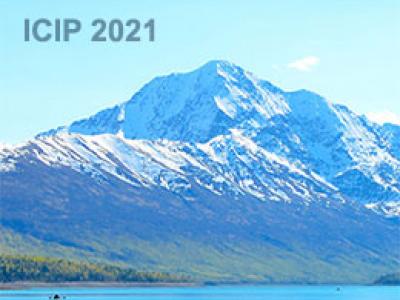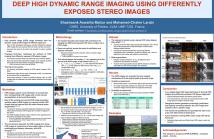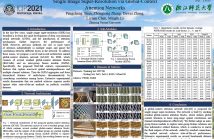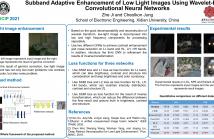
- Read more about A Hybrid Two stream Approach For Multi Person Action Recognition in Top view 360 degree Videos
- Log in to post comments
Action recognition in top-view 360° videos is an emerging research topic in computer vision. Existing work utilizes a global projection method to transform 360° video frames to panorama frames for further processing. However, this unwrapping suffers from a problem of geometric distortion i.e., people present near the centre in the 360° video frames appear highly stretched and distorted in the corresponding panorama frames (observed in 37.5% of the total panorama frames in 360Action dataset).
posterv6.pdf
video_pptv3.pdf
- Categories:
 72 Views
72 Views
- Read more about DEEP HIGH DYNAMIC RANGE IMAGING USING DIFFERENTLY EXPOSED STEREO IMAGES
- Log in to post comments
High dynamic range (HDR) image formation from low dynamic range (LDR) images of different exposures is a well researched topic in the past two decades.
However, most of the developed techniques consider differently exposed LDR images that are acquired from the same camera view point, which assumes the scene to be static long enough to capture multiple images.
In this paper, we propose to address the problem of HDR imaging from differently exposed LDR stereo images using an encoder-decoder based convolutional neural network (CNN).
- Categories:
 104 Views
104 Views

- Read more about Weighted Average Precision: Adversarial Example Detection for Visual Perception of Autonomous Vehicles
- Log in to post comments
- Categories:
 12 Views
12 Views
- Read more about Piecewise Bézier space: Recovering 3D dynamic motion from video
- Log in to post comments
In this paper we address the problem of jointly retrieving a 3D dynamic shape, camera motion, and deformation grouping from partial 2D point trajectories in a monocular video. To this end, we introduce a union of piecewise Bézier subspaces with enforcing continuities to model 3D motion. We show that formulating the problem in terms of piecewise curves, allows for a better physical interpretation of the resulting priors and a more accurate representation of the motion.
- Categories:
 16 Views
16 Views
- Read more about PLNL-3DSSD: Part-Aware 3D Single Stage Detector Using Local And Non-Local Attention
- Log in to post comments
Poster.pdf
- Categories:
 8 Views
8 Views
- Read more about Adaptive Signal Variances: CNN Initialization Through Modern Architectures
- Log in to post comments
Deep convolutional neural networks (CNNs), renowned for their consistent performance, are widely understood by practitioners that the stability of learning depends on the initialization of the model parameters in each layer. Kaiming initialization, the de facto standard, is derived from a much simpler CNN model which consists of only the convolution and fully connected layers. Compared to the current CNN models, the basis CNN model for the Kaiming initialization does not include the max pooling or global average pooling layers.
- Categories:
 19 Views
19 Views
- Read more about PSEUDO-LABEL GENERATION-EVALUATION FRAMEWORK FOR CROSS DOMAIN WEAKLY SUPERVISED OBJECT DETECTION slides
- 1 comment
- Log in to post comments
- Categories:
 13 Views
13 Views
- Read more about SINGLE IMAGE SUPER-RESOLUTION VIA GLOBAL-CONTEXT ATTENTION NETWORKS
- Log in to post comments
In the last few years, single image super-resolution (SISR) has benefited a lot from the rapid development of deep convolutional neural networks (CNNs), and the introduction of attention mechanisms further improves the performance of SISR. However, previous methods use one or more types of attention independently in multiple stages and ignore the correlations between different layers in the network.
1950_poster.pdf
1950_ICIP21.pdf
- Categories:
 48 Views
48 Views
- Read more about Subband Adaptive Enhancement Of Low Light Images Using Wavelet-Based Convolutional Neural Networks
- Log in to post comments
Images captured in low light condition have a narrow dynamic range with a dark tone, which are seriously degraded by noise due to the low signal-to-noise ratio (SNR). Discrete wavelet transform (DWT) is invertible and thus is able to decompose an image into subbands without information loss minimizing redundancy. In this paper, we propose subband adaptive enhancement of low light images using wavelet-based convolutional neural networks. We adopt DWT to achieve joint contrast enhancement and noise reduction. We combine DWT with convolutional neural networks (CNNs), i.e.
- Categories:
 39 Views
39 Views